Maintaining productivity throughout the day can be challenging, even for the most motivated individuals.
Despite our best efforts, it’s often easy to succumb to brain fog and get distracted from the task at hand. However, with the right tools, staying productive and consistently achieving your goals is easy.
This article will explain what productivity is and why it’s important, share 12 surprisingly simple productivity tips, and offer advice on how to maintain productivity (especially when life gets complicated).
Let’s jump in.
What is productivity?
Productivity is essential for success. But what exactly does it mean?
Productivity refers to an individual’s, group’s, or organization’s ability to efficiently complete daily tasks or produce goods and services.
Contrary to popular belief, productivity isn’t a personality trait that a person is born with but a skill that can be learned and developed. It involves working strategically to optimize the use of resources, eliminate inefficiencies in workflows, and produce high-quality work within a given time frame.
Productivity is influenced by multiple factors, including:
- Quality and style of leadership
- Organizational culture
- Work environment
How do you measure productivity?
The most common way to measure productivity is by calculating the ratio of output to input.
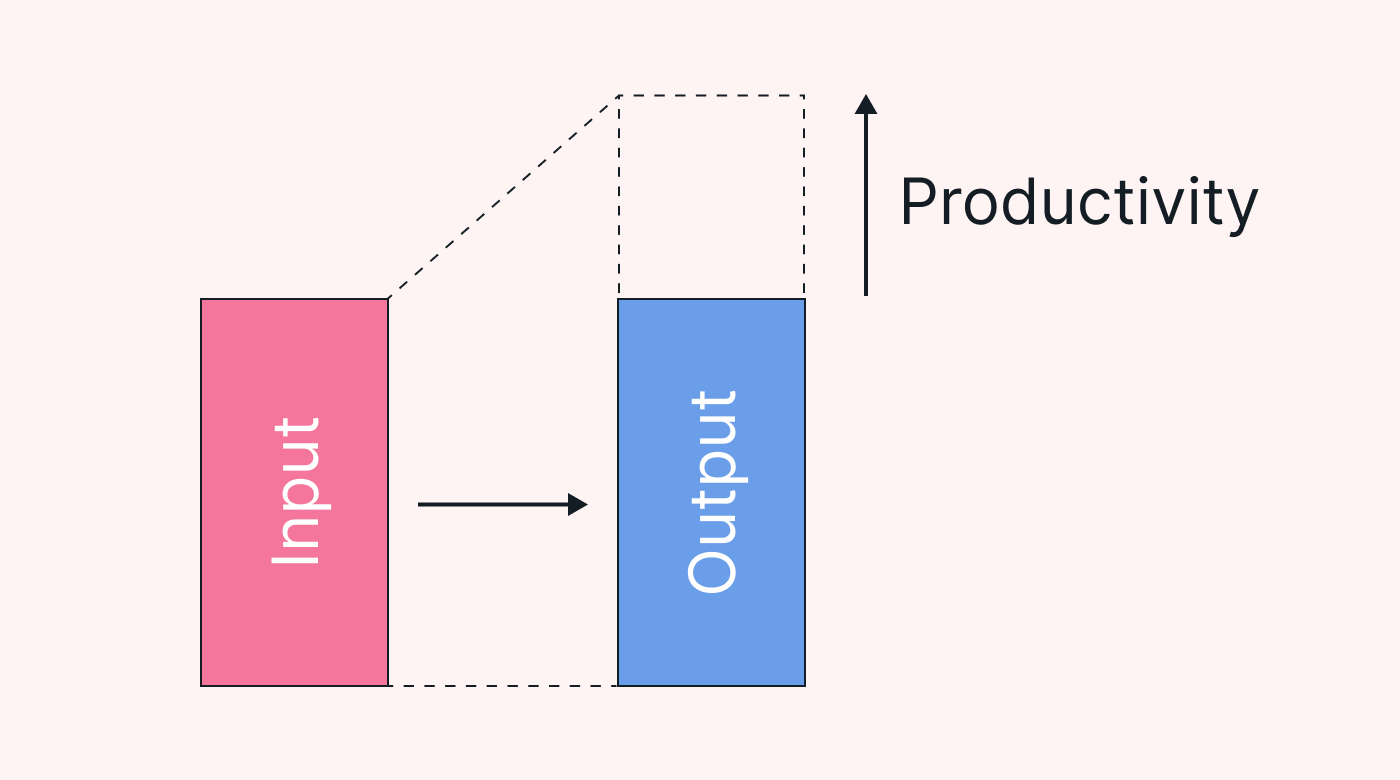 |
For example, let’s imagine you own a manufacturing company. Here’s how you might calculate your hourly productivity rate when making gadgets:
Input:
- Labor: number of hours worked by employees
- Capital: cost of materials, machinery, and equipment used in production
- Energy: electricity consumed in the production process
Output:
- Number of gadgets produced
- Revenue generated from the sale of gadgets
To calculate your productivity rate, determine the exact figures for each input/output point, such as 10,000 gadgets produced, 1,000 hours of labor, $50,000 worth of materials, and $10,000 worth of energy.
Then, divide the number of gadgets made by the total input resources used in the production process.
The equation for this would be as follows:
Productivity = 10,000 gadgets / (1,000 hours of labor + $50,000 worth of materials + $10,000 worth of energy)
In this example, the productivity rate is 10 gadgets per hour of labor and $6 of input resources.
Measuring productivity can help you identify areas where you can improve your efficiency, such as reducing the amount of energy your company consumes or optimizing the amount of materials used to produce a project.
12 ways to increase productivity
Implementing effective strategies can help increase productivity measurably and simply by improving focus, reducing distractions, and providing a clear roadmap to achieve desired outcomes.
Here are 12 practical ways to increase productivity:
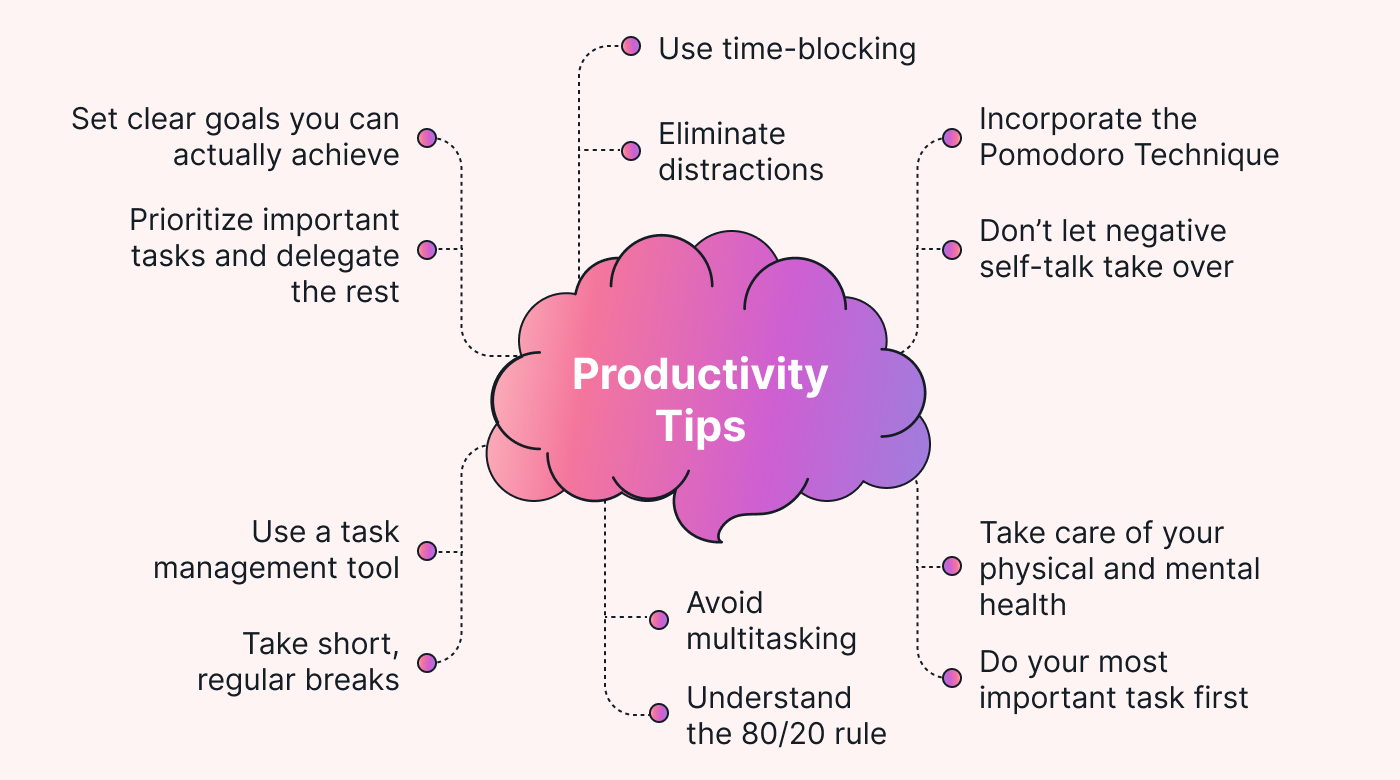 |
1. Set clear goals you can actually achieve
Employees with clearly defined goals are “…3.6 times more likely to be committed to their organization.”
Goal setting increases productivity and satisfaction in the following ways:
- It encourages focusing on one goal within a given time frame
- It provides external motivation
- It promotes a two-way accountability system
According to the University of Arizona, “…sometimes a quick win in the short term can be a springboard towards an overall goal or strategy.”
By setting challenging but achievable goals, you can experience quick wins that motivate you to continue working toward your ultimate objective.
Using different goal-setting strategies can be a helpful way to increase workplace productivity without setting unrealistic expectations.
Some examples of such strategies include the following:
- Using the Specific, Measurable, Achievable, Relevant, and Time-bound (SMART) goals framework
- Using the objectives and key results (OKR) methodology
- Backward goal setting
2. Prioritize important tasks and delegate the rest
Distinguishing between tasks that should be prioritized and those that should be delegated is a skill productive people use to save time and increase their productivity.
Dedicated employees often find it difficult to maintain a healthy work-life balance, as prioritizing tasks can be a time-consuming and stressful process.
However, new AI tools like Motion can solve this problem by automating task prioritization. Motion can increase productivity by 137%, as it takes the responsibility of delegating and prioritizing out of your hands so that you can focus solely on completing essential tasks.
3. Take short, regular breaks
If you’re the kind of person who feels guilty about taking breaks while working, we have some news for you: 64% of participants who take “micro-breaks” perform better than those who don’t.
Taking regular breaks can boost performance and productivity by:
- Improving your focus
- Reducing your stress level
- Increasing your creativity
4. Use a task management tool
Task management tools like Motion can help you stay organized, track your progress on different work projects simultaneously, and set automated deadlines to ensure you stay on track.
Using multiple types of software at the same time, especially when collaborating with other team members in business meetings or working from home, can lead to information or work getting lost.
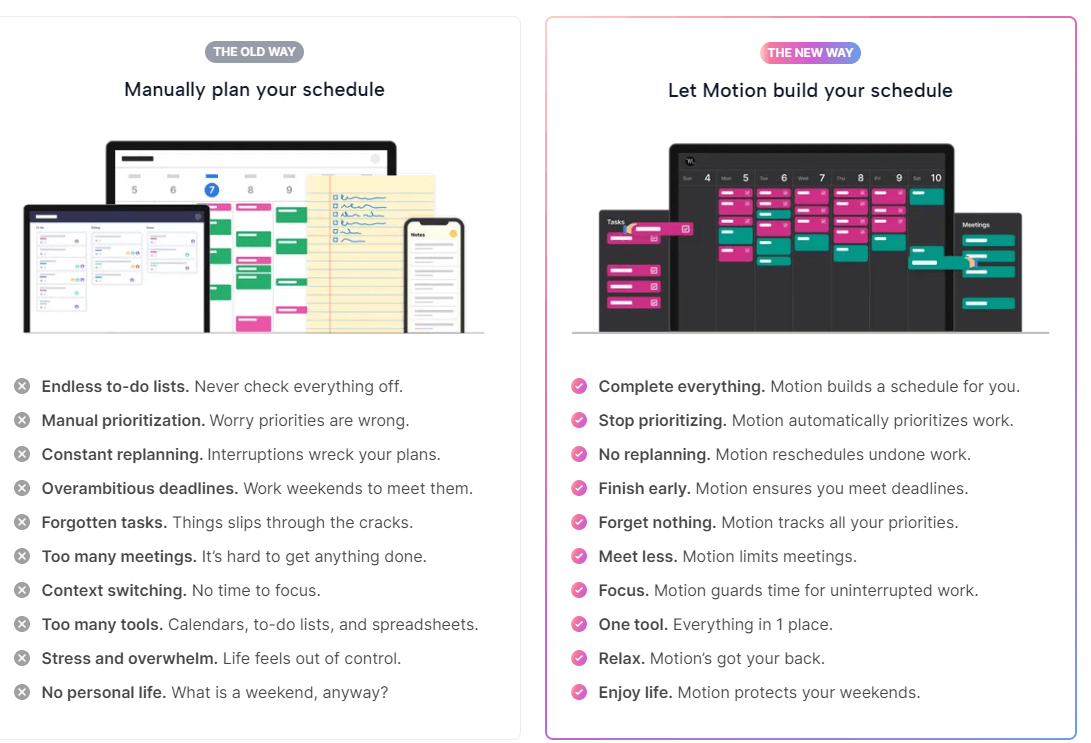 |
That’s why an all-inclusive task management tool that automatically sets up meetings, helps you complete your daily goals, and supports communication with your team can increase your daily productive time.
5. Avoid multitasking
According to Oxford University, while multitasking is a deeply rooted aspect of our modern society, it leads to “…suboptimal decision-making and decreased task performance.”
Here are some of the reasons why multitasking decreases productivity:
- It increases the chance that you’ll make errors or overlook important details
- It affects your ability to generate new and creative ideas
- It impacts your focus and momentum
- It spikes your stress level
Try giving “single-tasking” a go instead.
6. Use time-blocking
Time-blocking involves breaking up your day into specific time blocks with each one dedicated to different tasks and activities according to your daily schedule.
How this works:
- Identify your most important tasks
- Determine how long each task usually takes
- Allocate sections of time into your calendar to get those tasks done
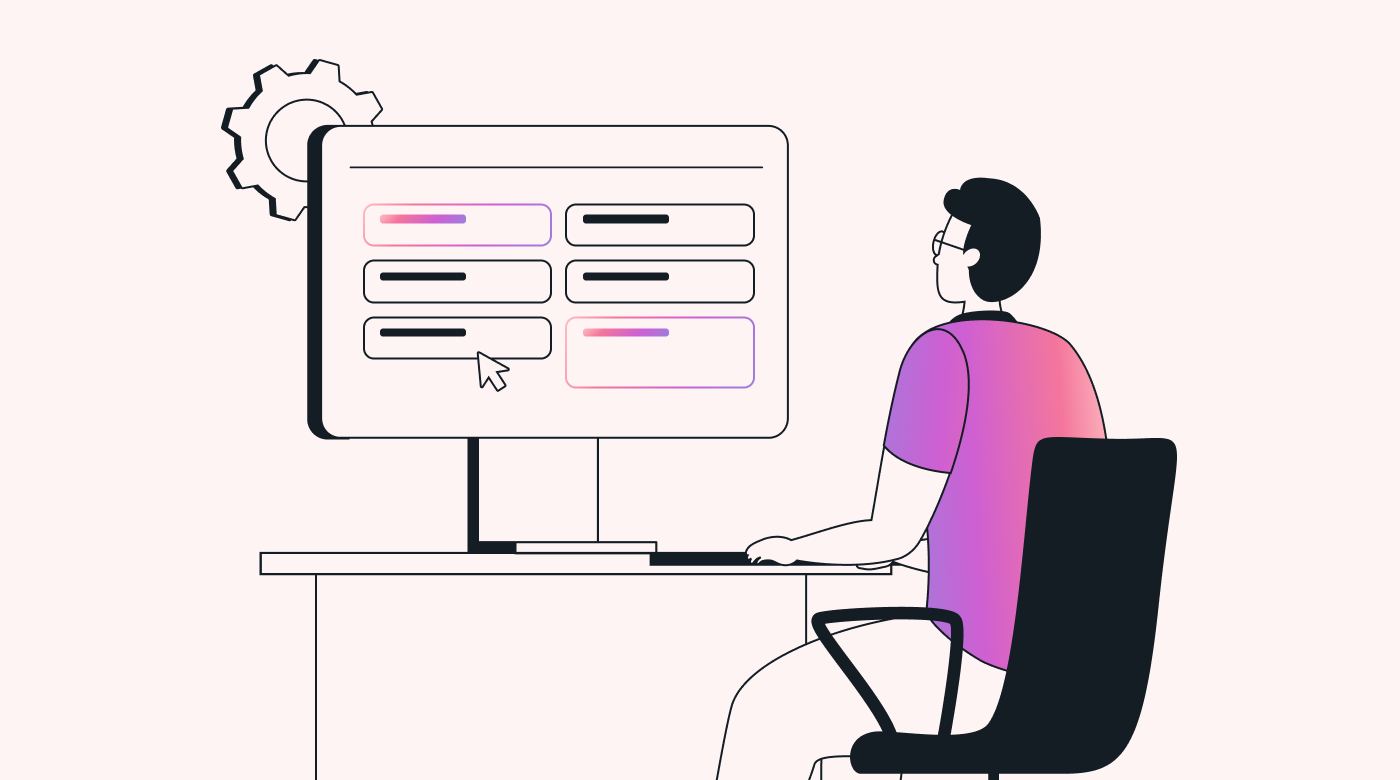 |
Many people are rejecting traditional to-do lists and instead choosing to use Motion, an AI time-blocking software that calculates your weekly tasks, meeting hours, and total work hours. It then builds a custom schedule to help you get everything done in as short a time frame as possible.
7. Don’t let negative self-talk take over
While “…self-respect may be more beneficial for executive functions than self-criticism,” many of us still find it difficult to turn off the part of our brain that tells us that we aren’t good enough.
Negative self-talk can:
- Reduce motivation
- Increase procrastination
- Lower self-confidence
- Impair decision-making
While it’s unrealistic to say that you should never have a negative thought ever again, striving to avoid giving power to this way of thinking is a good idea.
Here are some strategies that can help with this:
- Challenge negative thoughts by interrupting them with positive affirmation
- Focus on actionable solutions
- Seek support from colleagues or friends
- Don’t take critique personally
8. Take care of your physical and mental health
Taking care of yourself physically and mentally can significantly improve your ability to concentrate and process new information.
Here are some tips for taking care of your well-being:
Physical health tips:
- Get 7–8 hours of sleep every night (without exception)
- Exercise 3–5 times a week
- Eat healthily
- Practice mindfulness activities, like meditation or yoga
Mental health tips:
- Set boundaries for after-work hours
- Connect with friends, family, and colleagues
- Take dedicated time off work
Remember, continuously neglecting the needs of your body and mind increases your chances of becoming unwell, which can affect your ability to work.
9. Eliminate distractions
Distractions are everywhere in today’s world. This often makes it hard to fully “switch on” when starting work.
Instead of trying to work around distractions in your personal life and resisting the temptation to engage with them, try creating as much physical and mental distance between yourself and any potential distractions as possible. You’ll find that this is more effective.
Here are some ways you can do that:
- Create a distraction-free zone in your house or workplace
- Clean your space and create a stationery organizational system
- Use app blockers or disconnect the internet
- Work in a room with a door you can close
10. Understand the 80/20 rule
The 80/20 rule is the principle that roughly 80% of “effects” come from 20% of “causes.”
Understanding this rule can help you determine the most important tasks or activities that have the biggest impact on your work.
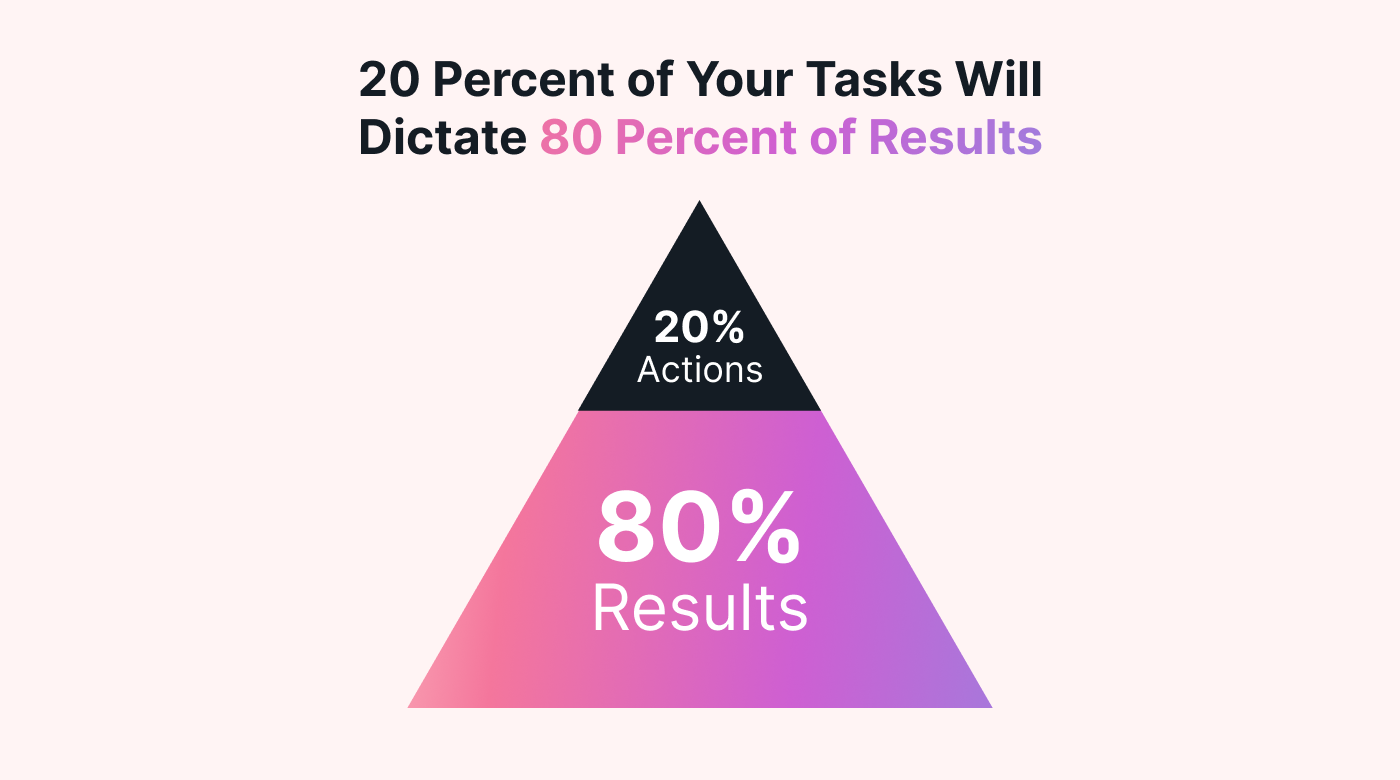 |
For example, if you’re in sales, you may find that 80% of your revenue comes from 20% of your clients. This information can guide you on how to prioritize your work so you can develop effective sales strategies with less effort.
11. Incorporate the Pomodoro Technique
The Pomodoro Technique is one of the most popular productivity techniques. It involves breaking work into intervals of about 25 minutes each, with short breaks in between.
Here’s how it works:
- Choose a task to work on
- Set a timer for 25 minutes
- Work for the set amount of time
- Take a short break (5–10 minutes)
- Repeat the process four times. Then, take a longer break (15–30 minutes)
Breaking work into manageable intervals reduces procrastination and fatigue.
A tool like Motion can help you complete deep work for more extended periods and save you 30.3 days per year.
12. Do your most important task first
Also known as “eating the frog,” tackling your most important task first is an astonishingly simple yet effective way to increase productivity.
Some benefits include the following:
- Increased focus
- The building of momentum
- Reduced stress levels
What are 3 benefits of productivity?
Productivity offers advantages that extend beyond completing tasks quickly.
Here are just three examples:
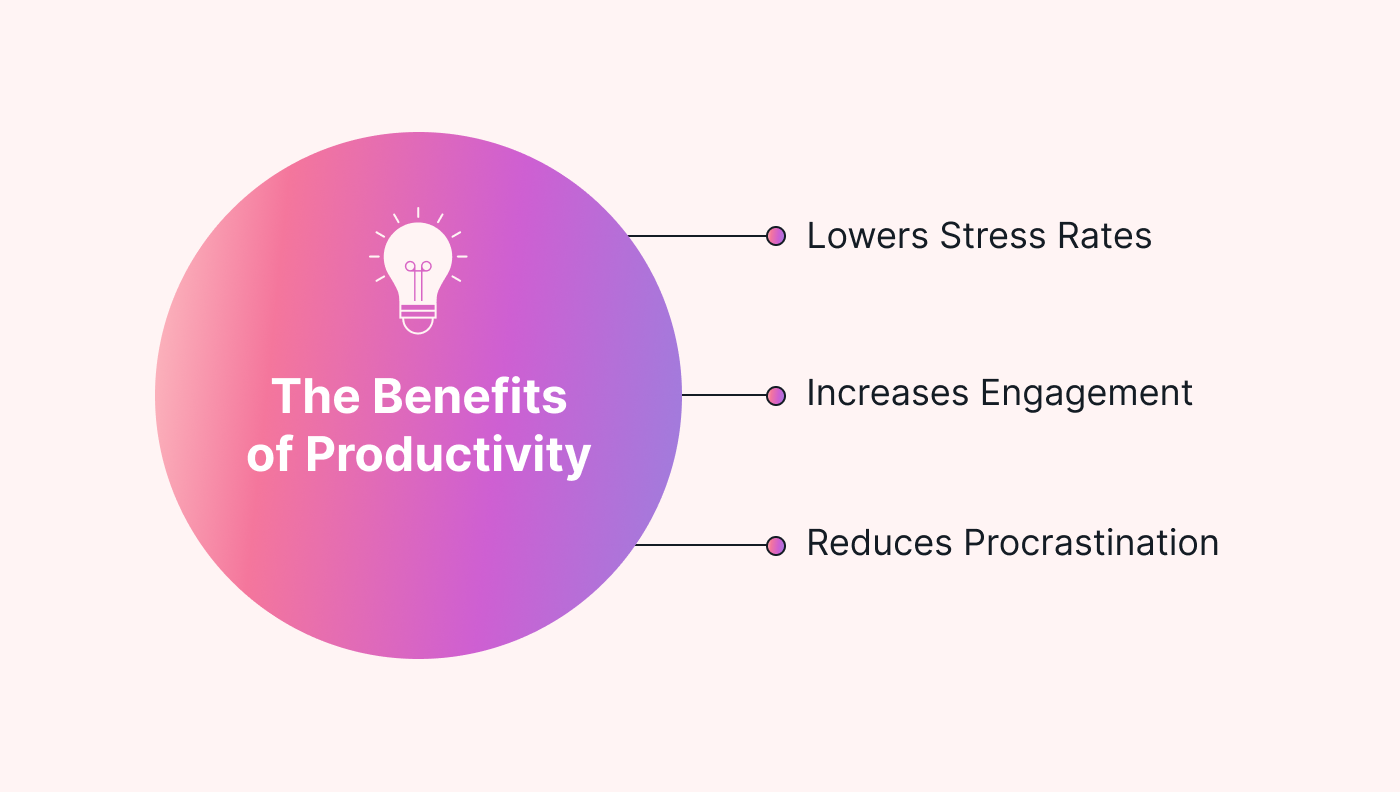 |
1. Lowers stress rates
In 2021, over 275 million working days were forfeited as a result of stress.
High stress levels can significantly hinder a person’s ability to concentrate, making it difficult to complete even the most crucial tasks.
Fortunately, increased productivity can help this by:
- Boosting self-esteem
- Helping with time management
- Improving work-life balance
- Providing a sense of accomplishment and control
Incorporating productivity and other stress relief strategies into your daily routine (such as exercise and mindfulness) can improve your ability to create meaningful work.
2. Increases engagement
A 2023 report highlights that “…companies with highly engaged workforces had better financial outcomes, outperforming the S&P 500 after a year.”
Engagement in the workforce refers to the commitment, motivation, and satisfaction employees feel toward their role in an organization.
Productivity can increase employee engagement, as it involves:
- Goal setting
- Feedback
- Training and development
Ultimately, prioritizing productivity and creating a positive work culture can lead to a higher level of commitment from employees.
3. Reduces procrastination
Although we all know that procrastinating on important work tasks leads to anxiety and missed opportunities, we tend to do it anyway.
One of the most effective ways to reduce procrastination is by breaking down tasks into small, manageable steps that feel easier to accomplish and rewarding yourself when you complete each milestone.
In fact, it was recently confirmed that “…work productivity has a positive and significant effect on employee performance.”
This can be linked to the fact that productivity involves the following:
- Prioritizing important tasks over immediate gratification
- Enforcing personal accountability
- Managing time effectively
Productivity can also help a person overcome the fear of failure that often leads to procrastination.
How do you maintain productivity?
Increasing productivity is an accomplishment, but it’s equally important to maintain a consistent level of productivity over time. A workflow without consistency can suffer.
Remember that focus and motivation can be fleeting, and investing time in yourself and creating good habits is invaluable. Without a solid foundation, periods of extremely low energy and burnout are likely to occur.
That’s where the balance of self-discipline and self-care comes into play.
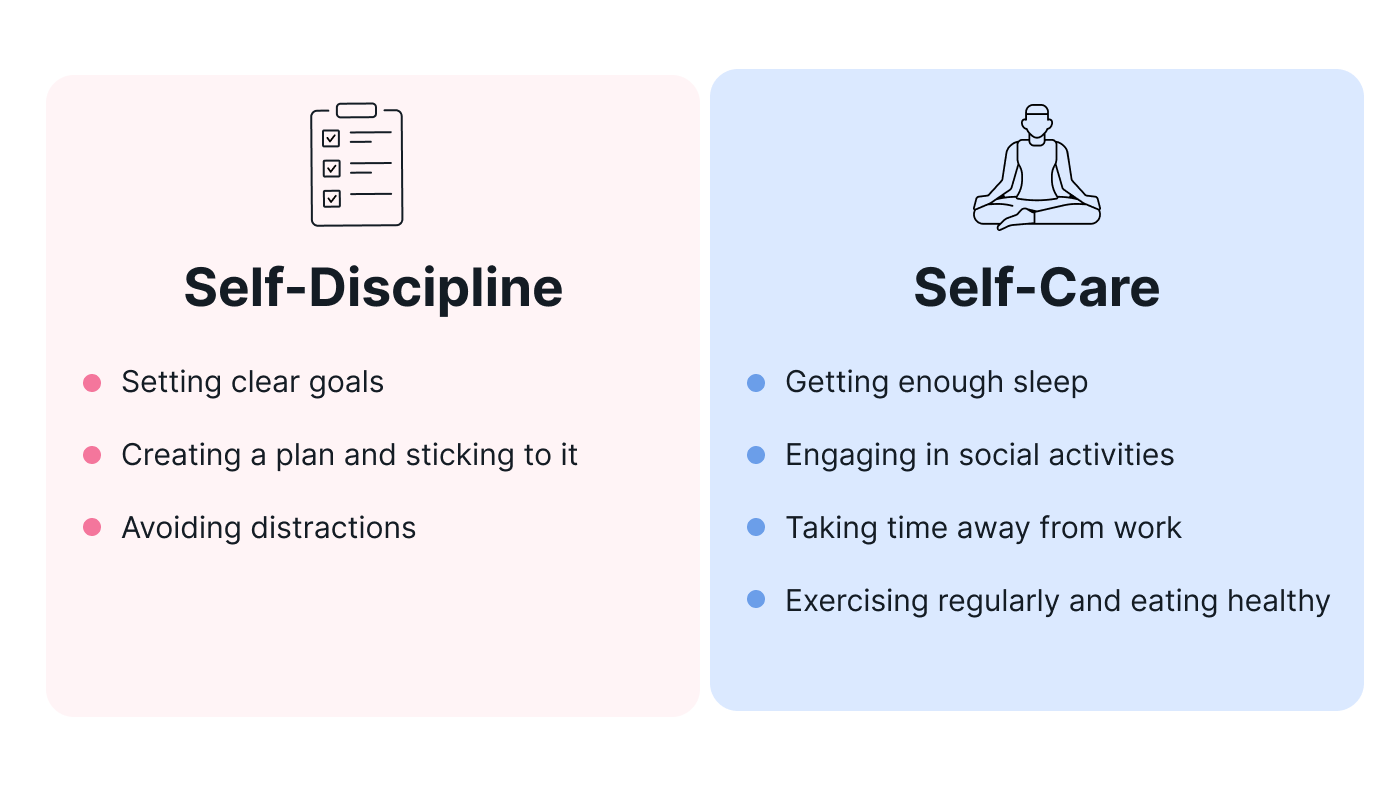 |
Self-discipline:
- Setting clear goals
- Creating a plan and sticking to it
- Avoiding distractions
Self-care
- Getting enough sleep
- Engaging in social activities
- Taking time away from work
- Exercising regularly and eating healthy
Adopting good habits and strategies that promote self-discipline and self-care is essential to maintaining productivity. Striking a balance between these two types of self-management systems is crucial to remaining productive in the long term.
For example, imagine you have a big work assignment due next week; however, in the process of getting everything done on time, you start binging on junk food, sitting in front of your desk for hours without taking breaks, and functioning on two to three hours of sleep per night.
In that scenario, it’s likely that your perceived productivity level would be high, but your output would be of a lower standard and would take longer than if you had considered your physical and mental needs.
Are you ready to conquer your goals?
Increasing productivity daily is not as difficult as it may seem.
Start by incorporating just 2 of our 12 productivity hacks into your workflow to see the difference yourself. If you notice that you can concentrate better, are completing tasks more efficiently, and aren’t procrastinating as much, you can take those results as a sign that the productivity tactics are working.
However, you don’t need to feel obligated to stick to the same routine. Change it up whenever you feel yourself slipping back into old habits.
Also, keep in mind that a task management tool like Motion is one of the most effective ways to increase productivity throughout the day. It juggles your priorities for you so you don’t have to.
To learn more and actually experience Motion’s Intelligent Calendar and all the productivity help it can provide, start your 7-day free trial.





